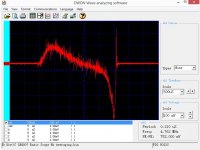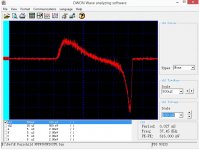Just seen in usenet / sci.electronics.design:
> Folks,
>
> ON Semi has just end-of-life'd their whole slew of electret microphone
> JFETs, TF202, TF252 and TF262.
regards, Gerhard
obviously MEMS is the way to go nowadays.
In general, that calculation is not correct. It is as Bob said, the delta-fuseimpedance against the load impedance on the fuse is what determines the distortion, although in some cases it may come out the same as your calculation.
Jan
Jan, if the load power is low (c.f Rin =100kmif I read correctly), thrn surges the fuse R modulation effects would be negligible?
Jan, if the load power is low (c.f Rin =100kmif I read correctly), thrn surges the fuse R modulation effects would be negligible?
Yes I think it is.
Jan
How does a rectifier have a "sound"? Any sort of data to show it's recovery/etc?
This is a rectifier that will have a "sound." And one that won't.
Attachments
Rectifiers have sound. I've been building the same circuit since 2010. Repetitive, long term efforts toward optimization have lead me to this. I don't have the time or equipment to do T&M on things like trr. But one thing most EE's don't do is build and audition the same circuit over and over and over. I do. Every preamp shipped from Lounge has been through my hands so far. One learns interesting facets of a circuit when you eat drink and sleep it for years.
Were these devices not a carry over from Sanyo? Lot of stuff has/will be going EOL if that is the case.
Which are Sanyo's best ss parts that we might use? Ones for which there is no substitute or equal.
THx-RNMarsh
It's a slow dog as a diode. See http://www.vishay.com/docs/91070/sihf840.pdfRectifiers have sound. I've been building the same circuit since 2010. Repetitive, long term efforts toward optimization have lead me to this. I don't have the time or equipment to do T&M on things like trr. But one thing most EE's don't do is build and audition the same circuit over and over and over. I do. Every preamp shipped from Lounge has been through my hands so far. One learns interesting facets of a circuit when you eat drink and sleep it for years.
I lament the passing of the bipolars for CRT deflection, 2SA1402/2SC3596. 700MHz, low output capacitance.Which are Sanyo's best ss parts that we might use? Ones for which there is no substitute or equal.
THx-RNMarsh
Yeah I have projects that take a whileRectifiers have sound. I've been building the same circuit since 2010.
That and hfa08tb60 are my faves. I only went down this path when the 1n5819's I was using were blowing once in a while. I was looking for something way over rated and with what I had on hand at the time those two were the best sounding drop ins.It's a slow dog as a diode. See http://www.vishay.com/docs/91070/sihf840.pdf
It's just a half wave recitfier feeding a series 2.2 ohm resistor and a 1000uf reservoir cap.
It was shocking how much cleaner those two sounded over the 1n5819.
Maybe a real snubber circuit would have helped the 1n5819 but once these were out and the Hexfreds or the IRF840 were in, the jump in resolution was not trivial.
Last edited:
This was a project before late 2010. Now it is a living.Yeah I have projects that take a while
5819s are schottkies and should require essentially no snubbing, at least for reverse recovery spikes. For the slower and larger transients from transformer ringing etc. then snubbers can be helpful across the transformer secondary.That and hfa08tb60 are my faves. I only went down this path when the 1n5819's I was using were blowing once in a while. I was looking for something way over rated and with what I had on hand at the time those two were the best sounding drop ins.
It's just a half wave recitfier feeding a series 2.2 ohm resistor and a 1000uf reservoir cap.
It was shocking how much cleaner those two sounded over the 1n5819.
Maybe a real snubber circuit would have helped the 1n5819 but once these were out and the Hexfreds or the IRF840 were in, the jump in resolution was not trivial.
I have my own proud flesh from using schottkies as rectifiers. Once Harman was courting IBM to supply powered speakers for PC use. The sales folks went to a meeting and hooked up the speakers and demoed the system. At that point IBM was buying a larger speaker from an Asian vendor, and was using a 24VAC power supply. I got a phone call.
"IBM asks if they can use their existing power supply with our speakers."
I said Absolutely NOT. They will blow up. Don't try it. If you want me to design speaker electronics for 24VAC operation, sure, be happy to do it.
So the meeting adjourned and people left the room. IIRC Harman did not get the business.
A week or so later the same contingent visited Packard Bell. I got a desperate whispered call from Tim P. "The speakers don't work!! How could this happen! How could you do this to us (implied at least)". I said Well the last I heard they worked fine at Armonk, and nothing's been done with them since.
What I wound up deducing was that after all but one skeptic had left the room at IBM, a bright a$$hole decided to disbelieve the information I provided and plugged in the 24VAC transformer to the Harman speaker. It didn't work, so he unplugged it and said nothing about it.
When I got the speakers back from the ill-fated demo at Packard Bell I found my schottky bridge was blown, and reconstructed the likely scenario.
But yes, all other things equal, schottlies are not as rugged as P-N rectifiers.
Sorry, I'm laughing now.It was a joke!
Very informative (and alarming) paper, thanks.JC..... dont forget about the C changes with temp and time. View attachment 551868
Dan.
Well at least you now know one reason why people tell you to use C0G and not XR5/7...Very informative (and alarming) paper, thanks.
Dan.
- Status
- Not open for further replies.
- Home
- Member Areas
- The Lounge
- John Curl's Blowtorch preamplifier part II

